History
50th State Big Time Wrestling (1936–1982)
Mid-Pacific Promotions was founded in 1936 by Russian emigrant Al Karasick. Assisted by booker Bobby Bruns, Karasick staged weekly shows in Honolulu's Civic Auditorium, which he managed. Thanks to Hawaii's tropical climate, Mid-Pacific Promotions emerged as a popular destination for wrestlers looking for a "working vacation", with high-profile wrestlers such as Lou Thesz and Rikidōzan visiting Hawaii. In 1949, Karasick joined the National Wrestling Alliance. In the early-1950s, Karasick began expanding into Japan, lobbying NWA president Sam Muchnick to recognise Japan as his territory. [3] [4] [8] [9] By the 1960s, Hawaii was established as a hub for American wrestlers travelling to and from Japan. [6]
In 1961, Karasick retired from promoting, selling the territory to "Gentleman" Ed Francis, who rebranded it "50th State Big Time Wrestling". [10] Francis continued promoting weekly Wednesday shows at the Civic Auditorium, with the venue regularly sold-out. [11] Shortly after Francis took over the promotion, a bout between Native Hawaiian wrestler King Curtis Iaukea and Samoan wrestler Neff Maiava resulted in a violent riot. [10] Francis appointed Lord James Blears as booker, with Blears quickly gaining a name for his "outrageous" and "goofy" characters. [6] The promotion's top stars included Johnny Barend, Curtis Iaukea, Don Muraco, Neff Maiava, Peter Maivia, and Sammy Steamboat. The promotion helped introduce several concepts that later became ubiquitous in professional wrestling, including the steel cage match and the backstage interview. [12] Johnny Barend became infamous for his outlandish interviews, which began with him emerging from a coffin while smoking a cigar. In 1967, Barend married Annie Lum in the ring at the Honolulu International Center shortly before a title match. [11] [13] [14]
Francis secured a Saturday afternoon live television slot on KHVH-TV. [5] As the promotion increased in popularity, it moved to KGMB and increased its output to two programs a week: a taped show featuring interviews, vignettes and replays on Friday nights and a live show on Saturday afternoons. [6] Hosted by Francis and Blears, 50th State Wrestling was at one point the most watched television program in Hawaii. [15] [16] [12] Television tapings rotated between Hawaii, Kauai, and Maui. In 1973, the television program changed to International All-star Wrestling, a 90 minute show airing on KGMB each Saturday. [17]
After the Civic Coliseum closed in 1974, Francis ceased promoting for three years. [17] In June 1977, he revived the promotion in the Honolulu International Center and the Bloch Arena. [17] [18] [6] With costs rising and revenues falling, Francis sold the promotion to Steve Rickard in April 1979 and retired from promoting. [11] [19] With Francis no longer promoting, Verne Gagne's American Wrestling Association expanded into Hawaii. [20]
Rickard ran weekly events at the Bloch Arena and monthly events at the Neal S. Blaisdell Arena, retaining Lord James Blears as his booker and commentator. He operated the promotion for around one year before selling his territorial rights to Peter Maivia. [2] [17]
Polynesian Pro Wrestling (1982–1988)
Peter Maivia renamed the promotion "Polynesian Pro Wrestling". Following Maivia's death in June 1982, his wife Lia Maivia took over the promotion. In August 1985, Polynesian Pro Wrestling's "A Hot Summer Night" event drew thousands of fans to the Aloha Stadium, however "A Hot Summer Night II" the following August was markedly less successful. In the late-1980s, the promotion suffered from a lack of large cities to promote in Hawaii, high costs of bringing in wrestlers with star power, and a lawsuit from a competitor. The promotion ultimately folded in 1988. [2]

George Emile Stipich was a Canadian professional wrestler, better known by his ring name, Stan Stasiak. He is best known for his appearances with the World Wide Wrestling Federation (WWWF) in the 1970s, where he won the WWWF Heavyweight Championship in 1973. He was inducted into the WWE Hall of Fame in 2018.

Rocky Johnson was a Canadian professional wrestler. Among many National Wrestling Alliance titles, he was the first Black Georgia Heavyweight Champion as well as the NWA Television Champion. He won the World Tag Team Championship in 1983, along with his partner Tony Atlas, to become the first black champions in WWE history. He is the father of actor and former WWE wrestler Dwayne "The Rock" Johnson and the grandfather of Simone Johnson.

Nicholas Warren Francis "Nick" Bockwinkel was an American professional wrestler. He is best known for his appearances with the American Wrestling Association (AWA) in the 1970s and 1980s.
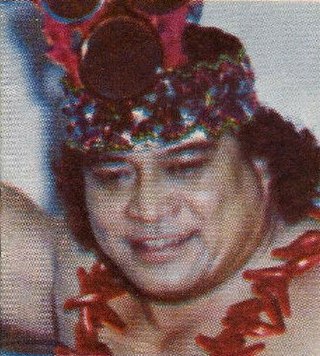
Fanene Leifi Pita Maivia, better known as Peter Maivia, was a Samoan-American professional wrestler, actor and stunt coordinator. Maivia was the grandfather of Dwayne "The Rock" Johnson via adoption, and was also part of the famous Anoaʻi family via blood brother pact. He was also the promoter of the National Wrestling Alliance member Polynesian Pro Wrestling in Hawaii.

Curtis Piehau Iaukea III was an American professional wrestler better known as King Curtis Iaukea. Iaukea won championships in several of the major regional U.S. promotions, both as a single and in various tag team combinations, during the 1960s. He then competed in the World Wrestling Federation (WWF) where he won the WWF Tag Team Championship with Baron Scicluna. He was also later The Master of the Dungeon of Doom in World Championship Wrestling (WCW). Under the name "Iau Kea" he appeared in the film The Three Stooges Go Around the World in a Daze with Moe Howard declaring "That's not a man! That's a committee!".
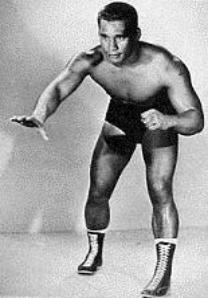
Samuel K. Mokuahi was an American professional wrestler, better known by his ring name, Sammy Steamboat.

Kurt and Karl Von Steiger were the ring names of Canadian professional wrestlers Lorne Corlett and Arnold Pastrick. The Von Steiger gimmick was that of two German villains, called heels, despite both wrestlers hailing from Winnipeg, Manitoba. Arnold Pastrick used the name Kurt Von Steiger, and Lorne Corlett worked as Karl Von Steiger. The Von Steigers are best known for competing in Pacific Northwest Wrestling in Portland, Oregon, between 1968 and 1973 but also competed in Tennessee, San Francisco, Stampede Wrestling, Australia, the American Wrestling Alliance and the Carolina territory.
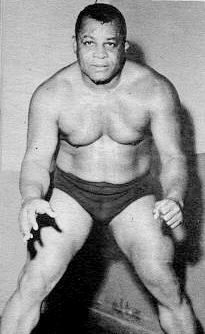
Luther Jacob Goodall was an American professional football player and wrestler, known by his ringname Luther Lindsay or Lindsey, who competed throughout the United States with the National Wrestling Alliance as well as international promotions such as All Japan Pro Wrestling, Joint Promotions and Stampede Wrestling.

Ofelia Maivia was a Samoan professional wrestling promoter. Maivia was the wife of Samoan professional wrestler Peter Maivia and the grandmother of actor and wrestler, Dwayne Johnson, also known as The Rock. Lia Maivia had an uncredited role in the Magnum PI episode "Mr. White Death". She played herself in her real life job as a wrestling promoter.

Professional wrestling in New Zealand has been promoted in the country from the early 20th century. In 1919, Gisborne Katene became the first national heavyweight champion, though the title was not recognized by the National Wrestling Association until 1925, and promoter Walter Miller began running events under the Dominion Wrestling Union banner ten years later.

On the Mat was a professional wrestling television programme for the National Wrestling Alliance-affiliated All Star Pro Wrestling (ASPW), or simply NWA New Zealand, that aired on Television New Zealand's TV2 from 1975 to 1984. One of the most popular and the longest-running weekly sports series in the history of New Zealand, the show featured some of the country's top wrestlers and international stars from throughout the world during the 1970s and early 1980s.

John R. Barend, better known as "Handsome" Johnny Barend, was an American professional wrestler.
Chris Markoff is a Yugoslav-American retired professional wrestler. He is best known for his appearances with professional wrestling promotions in the Midwestern United States in the 1960s.
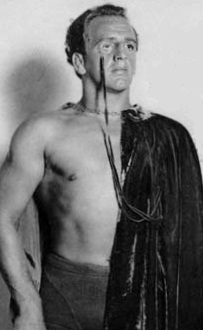
Lord Blears was a British-American professional wrestler, ring announcer, promoter, actor, mariner, and surfing personality.

Big Time Wrestling – also known as the American Wrestling Alliance (AWA) or National All-Star Wrestling, and sometimes referred to as NWA San Francisco – was a professional wrestling promotion headquartered in San Francisco, California, in the United States. Founded by "Professor" Roy Shire (1921–1992) in 1960, the promotion emerged as one of the most profitable in the United States thanks to its "red hot angles" and "good TV". The promotion's heartland was the San Francisco Bay Area, with the Cow Palace as its core venue, but it also ran regular shows in cities including Fresno, Las Vegas, Oakland, San Jose, and Sacramento. Shire folded the promotion in 1981.
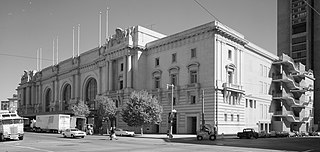
NWA San Francisco was a professional wrestling promotion headquartered in San Francisco, California in the United States. Founded in 1935 by "The Utica Panther" Joe Malcewicz (1897–1962), the promotion joined the National Wrestling Alliance in 1949. It traded until 1961, when it folded due to competition from the upstart Big Time Wrestling promotion. The promotion's heartland was San Francisco, with the San Francisco Civic Auditorium as its core venue, but it also ran shows in other Northern Californian cities including Fresno, Oakland, Richmond, Sacramento, San Jose, Santa Rosa, Stockton, and Vallejo.

Roy Lee Albern, known by the ring name Ripper Collins, was an American professional wrestler, who primarily wrestled for 50th State Big Time Wrestling, also known as NWA Hawaii.
Neff Alfred Maiava was an American Samoan professional wrestler. He is best known for his appearances in the United States with the Honolulu, Hawaii-based promotion 50th State Big Time Wrestling in the late-1950s and 1960s.
A Hot Summer Night: The '85 World Invitational Wrestling Spectacular was a professional wrestling supercard produced by NWA Polynesian Pro Wrestling (NWA-PPW), which took place on August 3, 1985, at the Aloha Stadium in Honolulu, Hawaii. An interpromotional show, it featured wrestlers from the American Wrestling Association, Jim Crockett Promotions and New Japan Pro-Wrestling.
A Hot Summer Night II was a professional wrestling supercard produced by NWA Polynesian Pro Wrestling (NWA-PPW), which took place on August 9, 1986, at the Aloha Stadium in Honolulu, Hawaii. Like the original show, this was an interpromotional event and featured representatives from All Star Pro Wrestling, the Continental Wrestling Association, Championship Wrestling from Florida, New Japan Pro-Wrestling and Stampede Wrestling.
















